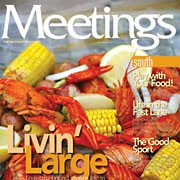Walking through historic Savannah, Ga., with its many public squares, stately mansions, moss-draped oaks, and cobblestone streets, is like taking a slow stroll through time.
The city, a major U.S. port on the Savannah River, harkens back to a more formal era, when men were gentlemen and women were ladies, and the rules of proper society were firmly woven into the tightly knit fabric of the community.
“Savannah is just a small Southern coastal town, and it was rediscovered in the decade of the ’90s,” says Harriet Meyerhoff, owner of Personalized Tours of Savannah (www.savannahsites.com), an independent tour company that operates a variety of programs, including tours of many restored mansions, available to groups visiting the city. “This used to be one of the Southern formal cities—very genteel, slow-moving. It’s moving along with the rest of the country now. It’s no longer a coat-and-tie town anymore, but a lot of the charm is still here.”
Its charm, in fact, saved Savannah.
Near the end of the Civil War, Union Gen. William Tecumseh Sherman—still reviled by most Southerners—burned the city of Atlanta and practically everything else in a wide swath stretching east to the Atlantic. Upon entering Savannah, however, it is said that Sherman was so impressed with the beauty of the town that he spared it the torch, and actually sent a telegram to President Abraham Lincoln on Dec. 22, 1864, offering the city as a Christmas present to his commander-in-chief.
Savannah’s grace and elegance also has made it the location of many motion pictures, including the somewhat scandalous Midnight in the Garden of Good and Evil, which introduced the city’s colorful drag performer Lady Chablis to the movie-going public.
Lady Chablis, in fact, is the embodiment, so to speak, of another interesting facet of Savannah: its history of cultural and religious diversity. The city is home to a sizeable Irish Catholic community—it boasts the second-largest St. Patrick’s Day celebration in the nation—and the third-largest synagogue in the U.S., with a large Jewish population that dates back to the 1730s. Savannah also boasts thriving African-American and gay communities.
“We see all types of people at parties,” Savannah native Meyerhoff says. “It’s a very eclectic community and everyone gets along, and that’s really unusual for a small Southern town.”
Besides the eclectic—some would say “eccentric”—nature of the citizenry, and the elegance of its many gardens and city squares, Savannah also serves a very utilitarian purpose, being the fifth-busiest container port in the U.S. Its port city history recalls a past as a major cotton shipping hub, and much of the cobblestone used to pave the streets of the 2.5-square-mile Savannah Historic District actually came to town as ballast in ships.
Meyerhoff, in fact, has a personal tie to the port, as her architect husband Eric designed the popular district in the late 1970s. Its primary tourist area, River Street, is filled with boutiques, antique shops, restaurants, and watering holes.
To help make planning meetings and conventions easier, the Savannah Area CVB (www.savannahvisit.com) offers a downloadable map and information about what it has dubbed the Historic Meetings District, a compact area that offers 17 hotels and 3,300 guest rooms in the heart of downtown, stretching from Savannah Harbor to Liberty Street.
After groups get their fill of the Old South refinement of Savannah, many programs include a round of golf on one of the area’s many courses, or a trip to the beaches of Tybee Island, located about 20 miles east of town.
But after a leisurely stroll through the tree-shaded streets of the Southern sweetheart of Savannah, it’s hard to imagine a more-pleasant way to while away a slow day.







